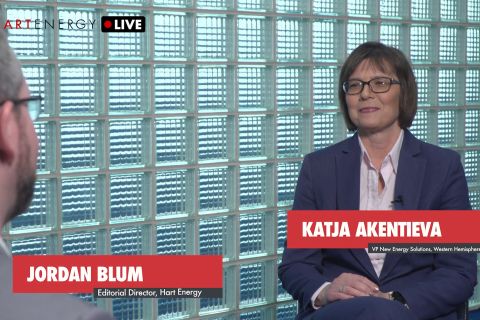Nowadays, 3-D reservoir models play an essential role in the assessment of hydrocarbon resources. They not only are used to estimate in-place volumes but also are the primary input to flow simulation for optimizing and forecasting how much resource can actually be recovered.
A 3-D reservoir model is a gridded numerical representation of the producing reservoir intervals. Each cell of the model must contain information about the rock type present at that location along with its porosity, permeability, and fluid saturation. These values are commonly distributed away from the wells using geostatistical modeling techniques. The input data for these algorithms include the interpreted well log values as well as parameters such as proportions of sands, average porosity, geological body dimensions, spatial correlation lengths, porosity-permeability relationships, saturation-height functions, etc., all of which are derived directly from well logs and cores.

FIGURE 1. On the top, a histogram shows the possible ranges of matrix and shale values used to calculate shale volume. The image on the bottom shows a range of shale volume results calculated from gamma ray. (Images courtesy of Paradigm)
- Uncertainty in hydrocarbon volumes is typically assessed through multiple realizations of the reservoir model's petrophysical content. Many models are generated using a fixed set of interpreted well logs and parameters derived from them. Given the overwhelming geological uncertainty present in all oil and gas reservoirs, any one of these models is a possible representation of the reservoir. However, by relying on a single set of well logs, the process of constructing alternative, equally probable reservoir models greatly underestimates the overall uncertainty for in-place hydrocarbons and thereby also the uncertainty in production forecasts.
The petrophysical logs used in reservoir models are the result of multiple processing and interpretation steps, each carrying their own uncertainty and aiming to solve an inverse problem that can lead to non-unique solutions. Capturing and quantifying uncertainty throughout the petrophysical analysis also can lead to multiple sets of well logs, each being a valid possibility. These multiple sets must be considered during the construction of the reservoir model as they will lead to different sets of input parameters, affecting quantity and connectivity of sands, porosity, permeability, and saturation distributions. The ability to propagate well log uncertainty all the way to production forecasts allows geoscientists and engineers to quantify its importance relative to other key subsurface uncertainty components.
Standard analysis
Unfortunately, well log uncertainty is seldom considered in reservoir models. In a standard deterministic petrophysical analysis, a petrophysicist selects one set of parameters for each zone of interest and passes on one set of well logs to the reservoir modeler. However, deciding what parameter to use during the analysis is not an objective matter. The petrophysicist often considers a most likely value somewhere between a minimum and maximum value for each parameter, which is generally estimated from experience or analog information. Thus, there is an acknowledged range of possibilities that can yield a range of interpreted results. Running a Monte Carlo analysis of the deterministic petrophysical workflow gives geoscientists a means to understand and quantify the impact of well log uncertainty on the overall uncertainty when assessing in-place hydrocarbon volumes.
Deterministic simulations
There are different ways of applying the Monte Carlo analysis, and many of these overestimate the resulting uncertainties if they do not account for dependencies and correlations between the various parameters used in the analysis. The Monte Carlo simulation must be performed in the same manner that a petrophysicist would typically work. For each iteration, one set of consistent parameters is used over a zone or depth range. Each resulting simulated log is then a valid possibility. Additionally, the impact that individual parameters have on volume estimates can be evaluated. The sensitivity analysis and resulting tornado charts are key in understanding which inputs drive uncertainty around resource estimates. This also aids in decisions on additional data acquisition to reduce uncertainty, if necessary, thereby lowering the risk.
A deterministic Monte Carlo analysis yields multiple realizations of porosity, water saturation, permeability, and other logs. From these coherent sets of logs, pessimistic, median, and optimistic cases can be extracted. For example, curves corresponding to P10, P50, and P90 values can be retrieved using an equivalent hydrocarbon column as a ranking criterion to compare alternative sets of logs. These can then be provided as input to a reservoir modeling system for a much more complete look at the overall uncertainty on hydrocarbons in-place and production responses. The more sets of logs that can be considered, the better, as they will allow a more comprehensive propagation of the uncertainties through the modeling process.
Consistent modeling

FIGURE 2. Facies log uncertainty is shown at different well locations from the three different Porosity logs (P10, P50, and P90). The model comprises two reservoir intervals referred to as A Sand toward the top and B Sand below.

FIGURE 3. Three different porosity distribution per facies defined from the porosity logs (P10, P50, and P90) are shown. A Sand corresponds to the top reservoir interval of Figure 2 and B Sand to the bottom one.
To construct a geologically consistent reservoir model, a hierarchical approach is taken where geological facies are spatially distributed first followed by porosity, permeability, and initial water saturation, capturing geological and physical dependencies. The first element impacted by well log uncertainty will therefore be the facies distribution. Figure 2 shows an example where pay sands are defined from a cut-off on porosity. Given three possible porosity logs extracted from petrophysical uncertainty analysis as described above, there will be three possible facies distributions, each exhibiting very different reservoir characteristics.

FIGURE 4. Oil-in-place estimates from 100 models use (a) a pessimistic, (b) a median, and (c) an optimistic set of logs. Section (d) is the result of 100 models combining all well log uncertainties.
Once the facies model is generated, porosity distributions are then simulated inside each facies. Since there are different porosity logs, each facies will have a different porosity distribution to honor during the simulation process. Figure 3 shows the different porosity cumulative distributions for each reservoir interval obtained from the P10, P50, and P90 porosity logs. Given these differences in a priori distribution, the overall simulation process will generate spatial porosity distributions that will cover a larger uncertainty spectrum than considering a single set of well logs.

FIGURE 5. A production profile at one well location shows the impact of uncertainty on logs. The three dashed curves correspond to similar geological models generated using three sets of logs.
The same conclusion applies to permeability and water saturation, providing an ensemble of reservoir models that capture a larger range of the overall uncertainty. Figure 4 compares oil-in-place estimates from 100 reservoir models using the pessimistic, the median, and the optimistic set of logs. Figure 4(d) corresponds to 100 models efficiently accounting for alternative well logs. Figure 5 shows the influence of the petrophysical uncertainties on cumulative oil produced as obtained through flow simulation. A similar reservoir model (i.e., same random path) is generated for each of the three sets of logs and associated derived parameters. The impact on estimated ultimate recovery is clearly visible.
Well log uncertainty too often is ignored in the reservoir modeling process, yet it can drastically impact in-place and produced volumes estimates. Although the conclusions are somewhat expected, it is important to note that these types of integrated studies are now possible, and by enabling the propagation of uncertainty from seismic and log interpretation to flow simulation, they allow a rigorous quantification of the overall uncertainty and associated risks.
Recommended Reading
Dominion Energy Receives Final Approvals for 2.6-GW Offshore Wind Project
2024-01-30 - Dominion Energy’s Coastal Virginia Offshore Wind project will feature 176 turbines and three offshore substations on a nearly 113,000-acre lease area off Virginia Beach.
Eversource to Sell Sunrise Wind Stake to Ørsted
2024-04-19 - Eversource Energy said it will provide service to Ørsted and remain contracted to lead the onshore construction of Sunrise following the closing of the transaction.
US Gives Final Green Light to Sunrise Wind Offshore Project
2024-03-26 - The approval by the Bureau of Ocean Energy Management solidified Ørsted and Eversource’s commitment to the project with both taking final investment decisions.
Exclusive: What’s Needed to ‘Get Things Moving’ with CCS
2024-03-05 - CCS momentum is brewing, says Katja Akentieva, vice president of New Energy Solutions for the Western Hemisphere at TGS. Now it's time to capitalize on that momentum in this Hart Energy LIVE Exclusive with Jordan Blum.
First US Utility-scale Offshore Wind Farm Starts Operations
2024-03-14 - The 12-turbine, 130-megawatt South Fork Wind project is a joint venture between Denmark's Orsted and New England-based electric utility Eversource.




